by | Dec 8, 2015 | 01 What's New, Ancestry, Cloud Backup, RootsMagic
I think this is a long post, but this is an extremely important topic. I hope you will invest the time to read it through to the end.

I travel the world presenting sessions on a wide range of genealogy topics. One of the presentations that is most near and dear to my heart is called Future Technology and Genealogy – 5 Strategies You Need. In it I not only outline 5 strategies that genealogists can use to cope and thrive in an ever-changing technological world, but I share 3 major areas that I believe genealogists should be aware of as we move into the future. One of those is the desktop moving to the Cloud.
Certainly Adobe and Microsoft have already moved that direction by discontinuing physical software sales and moving to a Cloud based subscription service. But the desktop moving to the Cloud has been a more subtle transition in the genealogy space. Today, however, our industry was hit between the eyes with this new reality.
 Ancestry has announced the “retirement” of one of the cornerstone products in genealogy, the Family Tree Maker desktop software.
Ancestry has announced the “retirement” of one of the cornerstone products in genealogy, the Family Tree Maker desktop software.
I couldn’t help but think that Ancestry was striving to paint a picture of Family Tree Maker as Charles Coburn (in black and white of course) in his classic double-breasted suit, gold watch in hand, walking off into the sunset in a Jean Arthur movie. Perhaps it would be more accurate to visualize him being pushed out. Let’s start with the announcment that Ancestry released on their blog late Tuesday December 8, 2015, and then we’ll probe deeper:
“Ancestry to Retire Family Tree Maker Software
By Kendall Hulet
Ancestry is proud to have made a significant investment this year to bring valuable new content and records to the Ancestry site. In 2015, we’ve made 220 million searchable historical records from Mexico available, more than 170 million pages from the largest collection of U.S. will and probate records, among others. We’ve also introduced new features such as Ancestry Academy and major advancements for AncestryDNA.
We remain dedicated to helping people gain new levels of understanding about their lives, and who and what led to them, harnessing the information found in family trees, historical records and genetics. As a company, we’re also continually evaluating ways to focus our efforts to provide the most impact and best product experience for our users through our core offerings.
True to this focus, we’ve taken a hard look at the declining desktop software market and the impact this has on being able to continue to provide product enhancements and support that our users need. With that, we’ve made the tough decision to stop selling Family Tree Maker as of December 31, 2015.
Our subscription business and website, on the other hand, continue to grow and we are doubling down our efforts to make that experience even better for our Ancestry community.
Ancestry will continue to support current owners of Family Tree Maker through January 1, 2017. During this time, all features of the software, including TreeSync™, will continue to work, and Member Services will be available to assist with user questions. We will also address major software bugs that may occur, as well as compatibility updates.
These changes are never easy, but by focusing our efforts, we can concentrate on continuing to build great products for our loyal Ancestry community.
If you have inquiries regarding Family Tree Maker, please reach out to our Member Services team. We’ll also provide updates on our blog as needed leading up to January 1, 2017.”
What this Means for Genealogists
In reality, I would wager to guess that this move is a cold, calculated business strategy, not a warm and sentimental retirement. And that’s OK. Business is good. If Ancestry didn’t do well in business, we wouldn’t have such easy and convenient access to all those records.
Discontinuing Family Tree Maker is a strategic move. The goal is it to get everyone from family history “dabblers” to seasoned genealogists to enter their family tree data directly onto a family tree housed on the Ancestry website. This puts them in the drivers seat.
It is keenly important to understand what is really happening so that you can make the wisest decisions possible for the life of your genealogical research. Our family trees are not Ancestry’s responsibility, or anyone elses for that matter. They are our responsibilities, and we need to be as calculated and ruthless in protecting them as any savvy CEO.
We must understand that it is more profitable for Ancestry to quit producing software CDs, and all that packaging to put the CDs in. It’s more profitable to stop employing and paying employees to ship all those CDs. Digital content is more profitable and easier for a company to control. But is that the whole story?
Absolutely not. Information is King, and it is valuable. Your genealogical information is financially valuable to genealogy companies. (Read Ancestry’s Terms of Service to refresh yourself on what they can do with your information.) Think AncestryDNA is only about your ancestry? You must understand that it is not. Aggregated data is sold in the marketplace to other companies. (Read this article at Wired.com about one partnership Ancestry has with the Google-owned biotech company Calico.)
Not to say it is not a worthwhile effort on your part to get your DNA tested – it certainly may be. But that DNA data has dollar signs written all over it. It is valuable. But today isn’t about DNA, so let’s get back to Family Tree Maker and your tree. How do you, the genealogist, retain control in this environment? Take on a “genealogist-protected approach” to your data.
The Genealogist-Protected Approach
Step 1: Purchase a new genealogy software database program and load it on your computer. I recommend and use RootstMagic software. RootsMagic is excellent, reliable and extremely well supported. Click here to read how they are ready to help you in our transition.
Step 2: Back up your entire computer with a Cloud-based backup service. This is critical to protecting and retaining control of your data. I recommend and use Backblaze. (Here’s an article I wrote that will give you a compelling reason not to skip this step.)
Full disclosure: RootsMagic and Backblaze are sponsors of the free Genealogy Gems Podcast. This is primarily because I use the products myself and have been impressed and satisfied with their products. Regardless of which products you choose, just be sure you put the Genealogist-Protected Approach into action.
I have stated numerous times in presentations, on the podcast, and here on the blog that I view family trees on Ancestry and other websites as “cousin bait” not primary family tree storage. Rather than upload my entire tree, I upload that for which I want to generate “genealogical leads.” My master tree and master database file is on my computer in RootsMagic, backed up by Backblaze.
You might be one of the many genealogists who has thoroughly enjoyed having your entire tree on Ancestry, and wonder now how you can get a software program that fully synchronizes with Ancestry. To address this issue, first go back and read the section above under “What this means for genealogists.” Remember, data is BIG business. The truth is that it is not financially beneficial to Ancestry to allow that to happen. They want to be where you house your master family tree. I don’t blame them. But, in my opinion, that’s not in my family tree’s best interest. Therefore, I follow the steps outlined above, and upload a gedcom of what I want circulating publicly in order to generate “leads”: hints and cousin connections.
 I believe it is generally going to get harder and harder to retain control over our privacy and our data. We don’t know what the future holds for computer software. But no matter what happens, we as genealogists will still be 100% responsible for what happens to our family trees and our data. There’s no whining in
I believe it is generally going to get harder and harder to retain control over our privacy and our data. We don’t know what the future holds for computer software. But no matter what happens, we as genealogists will still be 100% responsible for what happens to our family trees and our data. There’s no whining in  genealogy. And last I heard they still produce paper and pencils.
genealogy. And last I heard they still produce paper and pencils.
by Lisa Cooke | Nov 20, 2015 | 01 What's New, Ancestry, Cloud Backup, Disaster Prevention, Trees
THIS IS IT! Our #1 blog post of 2015. Not surprisingly, it’s about how to secure your data on Ancestry.com: your trees, photos, sources and even DNA! 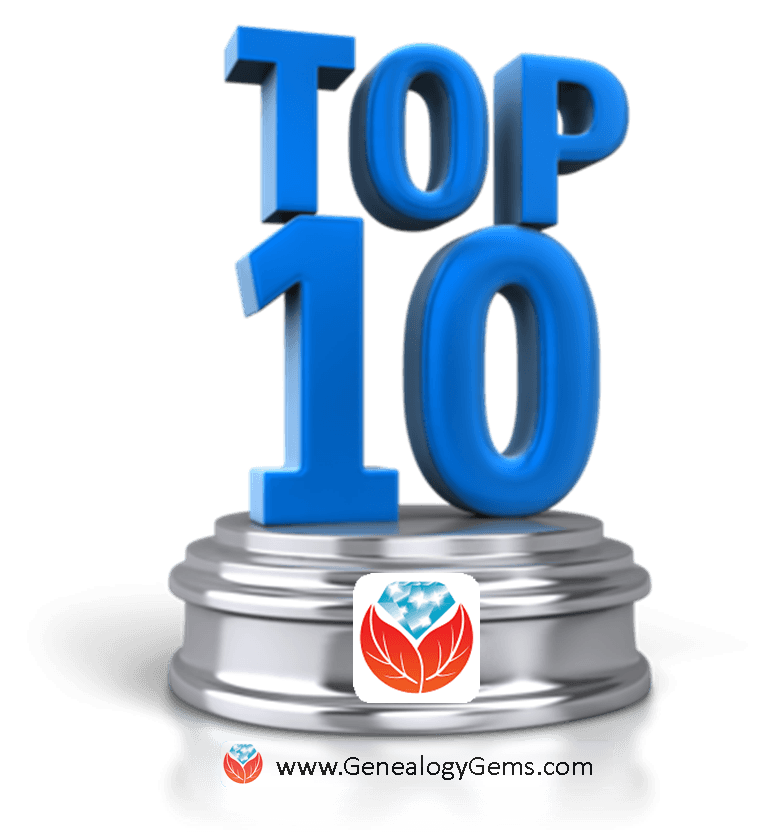
Earlier this year, rumors circulated that Ancestry was up for sale. Our post about that rumor included tips about how to back up everything you’ve put on Ancestry–trees, source citations, images and even DNA results. That post from our genealogy blog circulated among thousands and thousands of Facebook friends! It was definitely our most-read post of 2015, thanks to those of you who helped share its tips with your friends.
Here’s the bottom line from that post: if you don’t already have up-to-date copies of everything you’ve 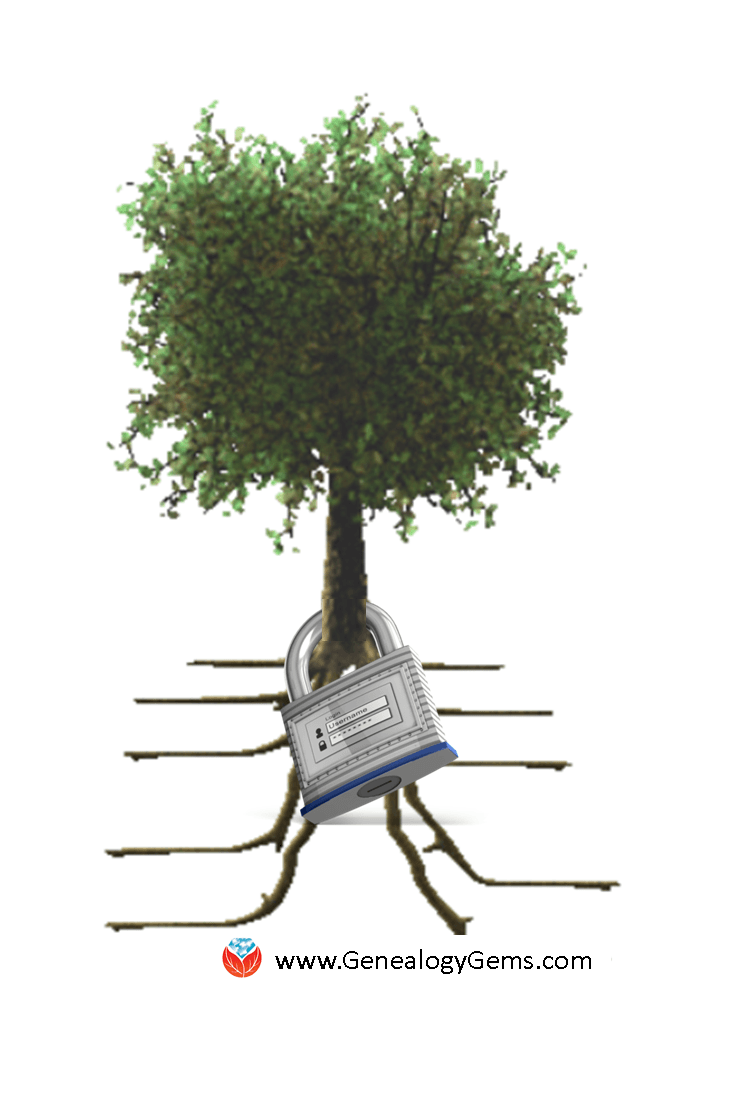 put on Ancestry, download it now. From here on out, keep your master family tree not on Ancestry (or any other site) but on your own computer. If you do keep building your tree on Ancestry, download updated GEDCOM files regularly. That way, if Ancestry gets hacked, goes out of business or even dumps your data (it’s happened before), you’ve still got your tree.
put on Ancestry, download it now. From here on out, keep your master family tree not on Ancestry (or any other site) but on your own computer. If you do keep building your tree on Ancestry, download updated GEDCOM files regularly. That way, if Ancestry gets hacked, goes out of business or even dumps your data (it’s happened before), you’ve still got your tree.
In that same spirit, back up 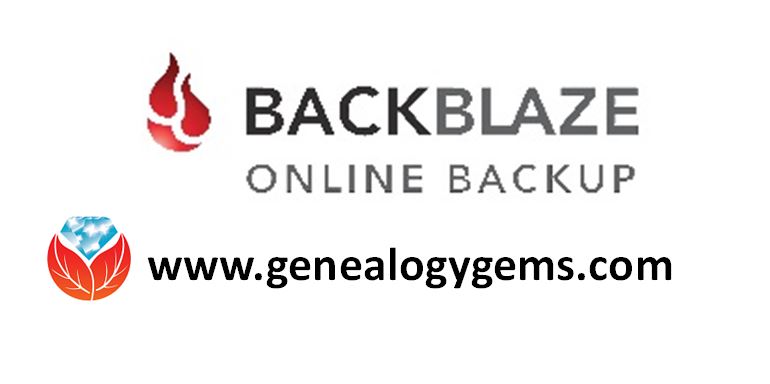 your own computer systems. Many of you have taken our advice to hire Backblaze to do this for you. Backblaze runs in the background of all Genealogy Gems computers, instantly backing up to the cloud every new or revised file we create, 24/7. Including our master family trees, digital photos and genealogy document images! Lisa loves that their online backup security is second to none and costs just $5 a month. (Click here to learn more about Backblaze.)
your own computer systems. Many of you have taken our advice to hire Backblaze to do this for you. Backblaze runs in the background of all Genealogy Gems computers, instantly backing up to the cloud every new or revised file we create, 24/7. Including our master family trees, digital photos and genealogy document images! Lisa loves that their online backup security is second to none and costs just $5 a month. (Click here to learn more about Backblaze.)
 Click here to see all Top 10 Genealogy Gems blog posts for 2015–and enter to win a great prize! The contest ends TODAY, so click now to enter!
Click here to see all Top 10 Genealogy Gems blog posts for 2015–and enter to win a great prize! The contest ends TODAY, so click now to enter!
by Lisa Cooke | Sep 23, 2015 | 01 What's New, Ancestry, images, Records & databases, Research Skills
Many of us already know that some of Ancestry’s content is free to search for everyone. But did you know that you can use Ancestry’s powerful search interface to search genealogy databases on OTHER websites, too? This includes sites that may be in another language–and sites you may not even know exist!
You may have heard that there’s a lot available on Ancestry for free to anyone. Like the 1940 and 1880 U.S. censuses. Australian and Canadian voter’s lists. A birth index for England and Wales. The SSDI. A few years ago, Ancestry also began incorporating off-site indexes into its search system. These are known as “Ancestry Web Indexes.” There are now more than 220 of these, and they point users to over 100 million records ON OTHER WEBSITES.
“Ancestry Web Indexes pull together a lot of databases that are already online from repositories all over the world, like courthouses and archives,” Matthew Deighton of Ancestry told me. “We index them here because we’ve found that people may not know their ancestor was in a certain region at a certain time. They may not know about that website that has posted those records. What you don’t know about, you can’t find.”
According to an online description, the guiding principles of Ancestry Web Search databases are:
- “Free access to Web Records – Users do not have to subscribe or even register with Ancestry.com to view these records;
- Proper attribution of Web Records to content publishers;
- Easy access to Web Records – Prominent links in search results and the record page make it easy to get to the source website.”
Better yet, you may have a better search experience at Ancestry than you would at the original site. Some sites that host databases or indexes don’t offer very flexible search parameters. They may not recognize “Beth Maddison” or “E. Mattison” as search results for “Elizabeth Madison,” while Ancestry would.
Results from Ancestry Web Indexes point you to the host website to see any additional information, like digitized images and source citations. A subscription to that site may be required to learn all you want from it. But just KNOWING that the data is there gives you the option to pursue it.
Doesn’t Google bring up all those same results if you just do a keyword search on your ancestor’s name? Not necessarily. Not all indexes are Google-searchable. Even if they are, Google may not present them to you until the 534th page of search results–long after you’ve lost interest.
And Ancestry specifically targets genealogically-interesting databases. Your results there won’t include LinkedIn profiles or current high school sports statistics from a young person with your ancestor’s name. (Learn how to weed out Google results like these with The Genealogist’s Google Toolbox by Lisa Louise Cooke.)
Some may be skeptical: isn’t it bad form for Ancestry to reference other sites’ material, especially when they often do so without consulting the host of the databases? They do have an opt-out policy for those who wish their databases to be removed from the search engine. Matthew says a couple of places have opted out–because the increased web traffic was too much for them to handle. That tells me that Ancestry Web Indexes are helping a lot of people find their family history in places they may otherwise never have looked.
Resources
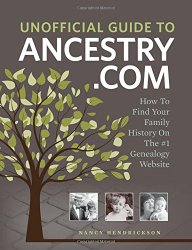
4 Tips for Getting the Most Out of Ancestry.com
Use Ancestry for Free at the Public Library: Tips in Genealogy Gems Premium Podcast episode #125, available to Genealogy Gems Premium website members
Unofficial Guide to Ancestry.com by Nancy Hendrickson, available in paperback and on Kindle!
 Thank you for sharing this post with others who will want to know what they can do for FREE on Ancestry!
Thank you for sharing this post with others who will want to know what they can do for FREE on Ancestry!
by Lisa Cooke | Sep 5, 2015 | 01 What's New, Ancestry
When you invest your money in a genealogy website, you want to ensure that you’re getting the most value possible. Here we share tips for getting the most out of Ancestry.com.
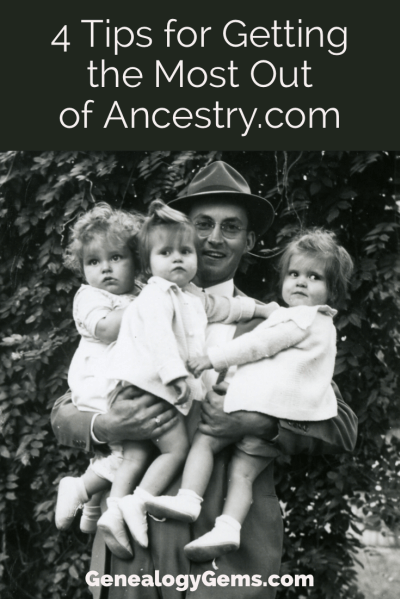
I noticed recently that Ancestry subscribers’ attitudes run the same gamut as attitudes of big-box retailer shoppers. Some people {heart} them unabashedly: they’ll spend hours strolling the aisles and share every great find on social media. Others dash in and grab just the items they can’t live without.
Whatever your stance toward the site, Ancestry is still the big-box retailer most genealogists need at some point. Take your cue from top big-box store shopping strategies for getting the most out of Ancestry.com:
1. Grab first what you can’t get anywhere else.
Learn what exactly you want from Ancestry versus other sites, the same way you’ve learned whose house brand of spaghetti sauce you like and who carries your favorite protein bars.
A few examples for U.S. researchers:
- Ancestry has the most U.S. census non-population schedules online. (They’ve padded HeritageQuest Online with several of these but they didn’t give them everything.)
- Ancestry’s collection of digitized U.S. city directories (over a BILLION) is second to none.
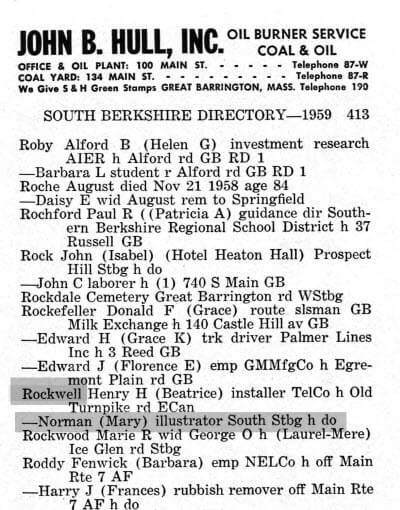
Beloved illustrator Norman Rockwell in a city directory. (Massachusetts Berkshire 1959 Berkshire, Massachusetts, City Directory, 1959)
2. Stock Up on Items that are Easy to Reach
While your subscription is active, stock up on easy to find items.
One way to do that is with Ancestry’s hints. Ancestry’s hinting system taps the most popular Ancestry collections (about the top 10% of the most popular collections). Watch your Ancestry tree for hints and check them all. When you first log in, note whether anyone new has taken an interest in your tree (if it’s public)–and see if they are relatives worth contacting.
3. Watch for New Products!
We’ve written about Ancestry updates that have stopped us in our tracks, like the recent U.S. Wills and Probates and Social Security Applications and Claims databases and the AncestryDNA Common Matches Tool.
We also update you regularly on new records collections that go online throughout the genealogy world: Ancestry databases are often among them.
You can also sort by “Date Added” in Ancestry.com Card Catalog. This is a great way to see the collections most recently added. Look for the green “NEW” tag.
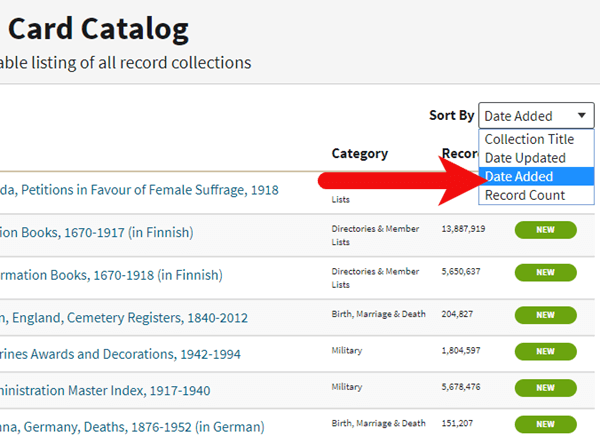
4. Avoid the Parts of the Experience that are Frustrating
Those who hate battling lines avoid big stores on peak shopping days and during the after-work rush. I avoid returning things at certain stores because their customer service desk is not worth the hassle.
Similarly, if the way Ancestry handles photos, sources, or Life Story timelines drives you nuts, ignore as much as you can except for your direct ancestors and closest relatives.
Perhaps you simply download each record you find and work with photos and timelines on your family history software (Lisa recommends RootsMagic–click here to read why). Or use Evernote’s newly updated web clipper (you can even make notes on top of your screen captures!) and store all your sources there.
Resources
Want to learn more about how to get the most out of Ancestry? Here are two additional resources:
Genealogy Gems Premium Podcast Episode 125: Using Ancestry Library Edition and other tips from a public library genealogist (available to Genealogy Gems Premium members only)
3 Things This Gems Follower Loves About the New Ancestry Site
by Lisa Cooke | Sep 2, 2015 | 01 What's New, Ancestry, images, Records & databases, United States
 More than 100 million people are mentioned in Ancestry’s newest database of U.S. wills and probate records, an exclusive collection spanning over 300 years. To celebrate, Ancestry is offering free access through September 7.
More than 100 million people are mentioned in Ancestry’s newest database of U.S. wills and probate records, an exclusive collection spanning over 300 years. To celebrate, Ancestry is offering free access through September 7.
This morning, Ancestry launched an enormous–and enormously significant–new online records collection. According to its press release, “More than 170 million pages from the largest collection of wills and probate records in the United States is now available online exclusively on Ancestry. With searchable records included from all 50 states spread over 337 years (1668-2005), this unprecedented collection launches a new category of records for family history research never before available online at this scale the United States.”
Wills and estate records are one of those record types that have been less-accessible online. First, the records themselves are not easy to digitize or even index. They are often thick files, packed with various kinds of documents that may be fragile and of varying sizes. Several people may be mentioned throughout the file, but finding and picking out their names to put in an index is time-consuming.
Furthermore, the U.S. has no central will or probate registry. This happens on a county level, generally. Compiling a centralized database from all those county offices or archives is a huge undertaking.
According to the Ancestry release, “Ancestry spent more than two years bringing this collection online, working with hundreds of different archives from individual state and local courts across the country and making a $10M investment to license and digitize the records.”
Better yet, “the documents cover well over 100 million people, including the deceased as well as their family, friends and others involved in the probate process. Ancestry expects to continue to grow the collection, with additional records available over the next several years.”
Todd Godfrey, VP of Global Content at Ancestry, loves the fact that wills and probate records can reveal not just names, dates and family relationships, but stories. “Wills can offer an incredible view into the lives of your ancestors…providing insight into their personality, character, achievements, relationships, and more,” said Godfrey. “Reading these records you will find a deeper level of understanding about who your ancestors were, who they cared about, what they treasured, and how they lived.”
Learn more about this collection in Finding Your Family in Wills and Probate Records (Ancestry’s new in-depth guide) or click here to search the collection. Great news for those without Ancestry subscriptions: The U.S. Wills and Probates collection is free to access on Ancestry, along with all U.S. birth, marriage and death records, through September 7 (10pm MT).
 Please share the great news! Click on your preferred social media channel on this page or copy the link into an email and send it out to your family and friends!
Please share the great news! Click on your preferred social media channel on this page or copy the link into an email and send it out to your family and friends!
Resources: More Great U.S. Records Online!
U.S. State Census Records: Capture Your Family History Between Federal Censuses
NEW! U.S. Social Security Applications and Claims Index
4 Fabulous Ways to Use the Library of Congress for Genealogy
Page 6 of 14« First«...45678...»Last »
 Ancestry has announced the “retirement” of one of the cornerstone products in genealogy, the Family Tree Maker desktop software.
Ancestry has announced the “retirement” of one of the cornerstone products in genealogy, the Family Tree Maker desktop software.  I believe it is generally going to get harder and harder to retain control over our privacy and our data. We don’t know what the future holds for computer software. But no matter what happens, we as genealogists will still be 100% responsible for what happens to our family trees and our data. There’s no whining in
I believe it is generally going to get harder and harder to retain control over our privacy and our data. We don’t know what the future holds for computer software. But no matter what happens, we as genealogists will still be 100% responsible for what happens to our family trees and our data. There’s no whining in  genealogy. And last I heard they still produce paper and pencils.
genealogy. And last I heard they still produce paper and pencils.


 put on Ancestry, download it now. From here on out, keep your master family tree not on Ancestry (or any other site) but on your own computer. If you do keep building your tree on Ancestry, download updated GEDCOM files regularly. That way, if Ancestry gets hacked, goes out of business or even dumps your data (
put on Ancestry, download it now. From here on out, keep your master family tree not on Ancestry (or any other site) but on your own computer. If you do keep building your tree on Ancestry, download updated GEDCOM files regularly. That way, if Ancestry gets hacked, goes out of business or even dumps your data ( your own computer systems. Many of you have taken our advice to hire
your own computer systems. Many of you have taken our advice to hire 









